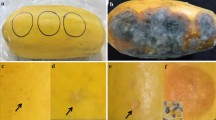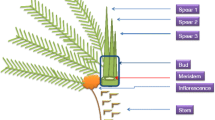Abstract
In late infection stages, rust fungi sporulate by building blister-like structures (pustules) in the mesophyll under the epidermal layer of their hosts. I investigated the host–pathogen interaction during pustule development and pustule opening in three different host–parasite combinations with different types of sori: Puccinia lagenophorae developing aecia, Phakopsora pachyrhizi developing uredinia, and Puccinia malvacearum developing telia. Light microscopy as well as scanning and transmission electron microscopy was applied. Although the development of the three host–parasite combinations varied in their soral development, there were common features detectable. During late infection stages, middle lamellae of mesophyll cells were dissolved locally to clear space for the pustule-building hyphae. Host cells were shoved aside, and hyphae adhering to host cells and to other hyphae by an extracellular matrix built new compact pseudoparenchyma, normally without killing host cells. The epidermal cells were separated from the mesophyll cells, and the growing pustule lifted up the covering tissue. The dissolution of the middle lamella of the anticlinal walls of the epidermal cells became visible. Scanning electron microscopy revealed that the epidermal cells collapsed over the bulging pustules, fissures appeared along cell boundaries, and finally the epidermal layer ruptured and the spores were set free. The interaction between hosts and pathogens is discussed.








Similar content being viewed by others
References
Childs SP, Buck JW, Li Z (2018) Breeding soybeans with resistance to soybean rust (Phakopsora pachyrhizi). Plant Breed 137:250–261. https://doi.org/10.1111/pbr.12595
Classen B, Amelunxen F, Blaschek W (2001) Ultrastructural observations on the rust fungus Puccinia malvacearum in Malva sylvestris ssp. mauritiana. Plant Biol 3:437–442
Cooper B, Campbell KB, Beard HS, Garrett WM, Islam N (2016) Putative rust fungal effector proteins in infected soybean leaves. Mycology 106:491–499
Cummins GB, Hiratsuka Y (2003) Illustrated genera of rust fungi. APS, St. Paul
Deising H, Rauscher M, Haug M, Heiler S (1995a) Differentiation and cell wall degrading enzymes in the obligately biotrophic rust fungus Uromyces viciae-fabae. Can J Bot 73(Suppl.1):S624–S631
Deising H, Frittrang AK, Kunz S, Mendgen K (1995b) Regulation of pectin methylesterase and polygalacturonase lyase activity during differentiation of infection structures in Uromyces viciae-fabae. Microbiology 141:561–571
Demers JE, Romberg MK, Castlebury LA (2015) Microcyclic rusts of hollyhock (Alcea rosea). IMA Fungus 6:477–482
Edwards HH, Bonde MR (2011) Penetration and establishment of Phakopsora pachyrhizi on soybean leaves as observed by transmission electron microscopy. Phytopathology 101:894–900
Escamez S, Tuominen H (2017) Contribution of cellular autolysis to tissular function during plant development. Curr Opin Plant Biol 35:124–130
Gerstenberger P, Leins P (1978) Rasterelektronenmikroskopische Untersuchungen an Blütenknospen von Physalis philadelphica (Solanaceae). Anwendung einer neuen Präparationsmethode Ber Dtsch Bot Ges 91:381–387
Goellner K, Loehrer M, Langenbach C, Conrath U, Koch E, Schaffrath U (2010) Phakopsora pachyrhizi, the causal agent of Asian soybean rust. Mol Plant Pathol 11(2):169–177
Gunawardena AHLAN, Pearce DME, Jackson MB, Hawes CR, Evans DE (2001) Rapid changes in cell wall pectic polysaccharides are closely associated with early stages of aerenchyma formation, a spatially localized form of programmed cell death in roots of maize (Zea mays L.) promoted by ethylene. Plant Cell Environ 24:1369–1375
Gunawardena AHLAN, John S, Greenwood JS, Dengler NG (2004) Programmed cell death remodels lace plant leaf shape during development. Plant Cell 16:60–73s
Heath MC (1981) Resistance of plants to rust infection. Phytopathology 71(9):971–974
Heller A, Thines M (2009) Evidence for the importance of enzymatic digestion of epidermal walls during subepidermal sporulation and pustule opening in white blister rusts (Albuginaceae). Mycol Res 113:657–667
Kemen E, Hahn M, Mendgen K, Struck C (2005a) Different resistance mechanisms of Medicago truncatula ecotypes against the rust fungus Uromyces striatus. Phytopathology 95:153–157
Kemen E, Kemen AC, Rafiqi M, Hempel U, Mendgen K, Hahn M, Voegele RT (2005b) Identification of a protein from rust fungi transferred from haustoria into infected plant cells. Mol Plant Microbe Interact 18(11):1130–1139
Kim KW (2015) Ultrastructure of the rust fungus Puccinia miscanthi in the teliospore stage interacting with the biofuel plant Miscanthus sinensis. Plant Pathol J 31(3):299–304
Koch E, Ebrahim-Nesbat F, Hoppe HH (1983) Light and electron microscopic studies on the development of soybean rust (Phakopsora pachyrhizi Syd.) in susceptible soybean leaves. Phytopathol Z 106:302–320
Kreisel M, Scholler M (1994) Chronology of phytoparasitc fungi introduced to Germany and adjacent countries. Bot Acta 107:387–392
Lennox CL, Rijkenberg FHJ (1989) Scanning electron microscopy study of infection structure formation of Puccinia graminis f.sp. tritici in host and non-host cereal species. Plant Pathol 38:547–556
Littlefield LJ, Heath MC (1979) Ultrastructure of rust fungi. Academic Press, New York
Littlefield LJ, Marek SM, Tyrl RJ, Winkelmann KS (2005) Morphological and molecular characterization of Puccinia lagenophorae, now present in Central North America. Ann Appl Biol 147:35–42
Mellersh DG, Heath MC (2001) Plasma membrane-cell wall adhesion is required for expression of plant defense responses during fungal penetration. Plant Cell 13:413–424
Mendgen K (1996) Fungal attachment and penetration. In: Kerstiens G (ed) Plant cuticles. An integrated functional approach. Bios Scientific Publishers Ltd, pp 175–188
Mendgen K, Struck C, Voegele RT, Hahn M (2000) Biotrophy and rust haustoria. Physiol Mol Plant Pathol 56:141–145
Mims CW, Richardson EA (2005) Ultrastructure of urediniospore development in Coleosporium ipomoeae as revealed by high-pressure freezing followed by freeze substitution. Int J Plant Sci 166(2):219–225
Mims CW, Richardson EA, Taylor J (2007) Ultrastructure of teliospore and promycelium and basidiospore formation in the two-spored form of Gymnoconia nitens, one of the causes of orange rust of Rubus. Can J Bot 85(10):935–940
Morin L, Talbot MJ, Glen M (2014) Quest to elucidate the life cycle of Puccinia psidii sensu lato. Fungal Biol 118:253–263
O'Donnell KL, McLaughlin DJ (1981) Ultrastructure of meiosis in the hollyhock rust fungus, correct: I. Prophase I - Prometaphase I. II. Metaphase I - Telophase I. III. Interphase I - Interphase II. 108:225–288
Ono Y, Buritica P, Hennen JF (1992) Delimitation of Phakopsora, Physopella and Cerotelium and their species on Leguminosae. Mycol Res 96(10):825–850
Ono Y (2006) Taxonomic implications of life cycle and basidium morphology of Ochropsora ariae and O. nambuana (Uredinales). Mycoscience 47:145–151
Petersen RH (1974) The rust fungus life cycle. Bot Rev 40:453–511
Qi M, Link TI, Mueller M, Hirschburger D, Pudake RN, Pedley KF, Braun E, Voegele RT, Baum TJ, Whitham SA (2016) A small cysteine-rich protein from the Asian soybean rust fungus, Phakopsora pachyrhizi, suppresses plant immunity. PLoS Pathog 12(9):e1005827. https://doi.org/10.1371/journal.ppat.1005827
Schmidt CS, Wolf GA (1999) Cellulase in the host-parasite system Phaseolus vulgaris (L.) - Uromyces appendiculatus (Pers.) Link. Eur J Plant Pathol 105:285–295
Scholler M, Lutz M, Wood AR, Hagedorn G, Mennicken M (2011) Taxonomy and phylogeny of Puccinia lagenophorae: a study using rDNA sequence data, morphological and host range features. Mycol Progress 10:175–187
Tiburzy R, Reisener HJ (1990) Resistance of wheat to Puccinia graminis f.sp. tritici: association of the hypersensitive reaction with the cellular accumulation of lignin-like material and callose. Physiol Mol Plant Pathol 36:109–120
Voegele RT, Hahn, M, Mendgen K (2009) The Uredinales: cytology, biochemistry, and molecular biology in: The Mycota, 5, Plant relationship/Vol. ed.: Deising HB. Springer 2.ed., pp 69–98
Yin C, Hulbert S (2011) Prospects for functional analysis of effectors from cereal rust fungi. Euphytica 179:57–67
Acknowledgements
Ms. Erika Rücker is gratefully acknowledged for technical assistance in electron microscopy, Ms. H. Popovitsch and Prof. Dr. R. Vögele for the infected soybean leaves, and Prof. Dr. O. Spring for the critical reading of the manuscript.
Author information
Authors and Affiliations
Corresponding author
Additional information
Handling Editor: Ulrike Mathesius
Publisher’s note
Springer Nature remains neutral with regard to jurisdictional claims in published maps and institutional affiliations.
Rights and permissions
About this article
Cite this article
Heller, A. Host-parasite interaction during subepidermal sporulation and pustule opening in rust fungi (Pucciniales). Protoplasma 257, 783–792 (2020). https://doi.org/10.1007/s00709-019-01461-4
Received:
Accepted:
Published:
Issue Date:
DOI: https://doi.org/10.1007/s00709-019-01461-4




